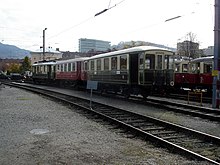Bavarian MBCL
| Bavarian MBCL / SETG MBC DR series ET 184.0 |
|
|---|---|
|
An MBC in Parsch, 1909
|
|
| Numbering: | K.Bay.Sts.B. 101-109, SETG 1-13 |
| Number: | 9 (K.Bay.Sts.B.) 13 (SETG) |
| Manufacturer: |
MAN / AEG (101–109) MAN / ÖSSW (1–10) Simmering / ÖSSW (11–13) |
| Year of construction (s): | 1907-1911 |
| Axis formula : | Bo |
| Genre : | BCiL |
| Gauge : | 1435 mm ( standard gauge ) |
| Length over coupling: | 10,250 mm |
| Length: | 9370 mm |
| Total wheelbase: | 4500 mm |
| Empty mass: | 17,000 kg |
| Service mass: | 17,200 kg |
| Friction mass: | 17,200 kg |
| Wheel set mass : | 8600 kg |
| Top speed: | 40 km / h |
| Hourly output : | 88 kW |
| Continuous output : | 74 kW |
| Starting tractive effort: | 1800 kg |
| Driving wheel diameter: | 850 mm |
| Power system : | 1000 volts direct current |
| Power transmission: | Overhead line |
| Number of traction motors: | 2 |
| Drive: | Paw camp |
| Brake: | electr. , Kpbr |
| Train heating: | electric |
| Coupling type: | Funnel coupling |
| Seats: | 32 |
| Classes : | 2nd / 3rd |
The Bavarian MBCL were electric railcars of the Royal Bavarian State Railways for the operation of the Königsseebahn and the Berchtesgaden – Hangender Stein local railway . Identical vehicles were put into service by the Salzburg Railway and Tramway Company (SETG) as the MBC series . At the Deutsche Reichsbahn (DR) they were classified in the class ET 184.0 from 1940 .
history
The railcars were built between 1907 and 1911 in a total of 21 copies for the three railway lines mentioned. The body of the first 19 railcars came from MAN . AEG supplied the electrical equipment for the Bavarian railcars, while the Salzburg railcars came from the Austrian Siemens-Schuckert-Werke (ÖSSW) and were only assembled in Salzburg after the cars had been delivered. By doing this, SETG saved the customs duties that would have been due when importing electrical equipment from Bavaria. The last three railcars in the series (MBC 11-13) were built by Simmering under license for SETG.
The railcars had the wheel arrangement Bo, they corresponded to the concept of the arrangement of interurban trams . They led the 2nd and 3rd car classes . Outwardly, the Bavarian wagons differed from the Austrian ones only in their color. While the coaches of the Royal Bavarian State Railways had a body in green-beige, those of the SETG were painted red-beige. The different engines, however, resulted in different performances: the Austrian railcars could carry three, the Bavarian railcars only two. The five Bavarian railcars of the second series (105-109) received a multiple control, so that train compositions of two railcars and up to five trailer cars were possible. The MPL 1501 baggage railcar was available as the sixth multiple-control motor vehicle , so that three sets could be formed.
In 1938 operations on the Berchtesgaden – Hangender Stein line were discontinued, and in 1942 the Königsseebahn switched to AC operation. Subsequently, the vehicles 184.02, 184.03 and 184.04 of the Deutsche Reichsbahn were moved to the Hohenfurth – Lippnerschwebe route in the Sudetenland, although the railcars 184.02 and 184.04 came to Stern & Hafferl on April 29, 1944 to be used on the Linz local railway . The railcars 184.01, 184.08 and 184.09 came in 1942/43 three came to SETG, which they classified under the numbers MBC 14-16 in the inventory.
In 1950 the three Bavarian and one Austrian railcars (MBC 5) were modernized by the SETG. Crossings and second-class compartments were omitted, and the railcars received more powerful engines. In this version they continued to be operated as the MC series. In 1954 the motor coaches MBC 1, 6 and 9 came to Stern & Hafferl and the motor coaches MBC 2, 10 and 11 were scrapped.
At the SETG successor company Salzburg AG a total of four vehicles have been preserved, one of them in the conversion variant as an MC. A former Bavarian vehicle was externally restored (with the exception of the pantograph) to the original condition of the Bavarian railcars. Other railcars are owned by the Bavarian Local Railway Association and the Mariazell – Erlaufsee museum tramway .
literature
- Manfred Angerer, Herbert Birkner: 120 years of Berchtesgaden railway history . ISBN 978-3-925647-54-3 .
- Horst J. Obermayer: Railcar . In: German Railways . Weltbild Verlag, Augsburg 1995, ISBN 3-89350-819-8 , p. 109 .
Individual evidence
- ^ Vyšebrodská elektrická dráha. Retrieved May 5, 2019 .
- ↑ Frydlant. Retrieved May 5, 2019 .
- ↑ a b Stern & Hafferl (20) railcars. Retrieved May 5, 2019 .
- ↑ SETG traction vehicles 1909 - 1953. Retrieved May 5, 2019 .

